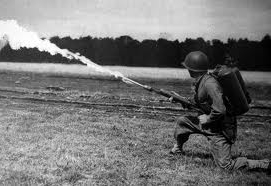


(Read all about the Great War and its impact on the history of Europe inside the pages of Military Heritage magazine.) However, its use was sporadic, confined to an isolated part of the Western Front, and so went largely unreported. The effect of the new weapon was medieval in the reaction it provoked when first used against French troops in October 1914. German Shock Troops Made Good Use of Flamethrowers A German flamethrower crew with fuel tanks and equipment.ĭespite the problems, both models came into service in the German Army during World War I. It was also so heavy that it could not be carried and operated by one man. It could sustain a jet of flame for almost 40 seconds but had major drawbacks in that it used more fuel and thus cost more to operate. The larger model, the grossflammenwerfer, or “large flame thrower,” worked in a similar fashion but had a range nearly twice that of the smaller model. Each time the operator wanted to fire a new burst he had to replace the ignition device, a serious inconvenience that led to a limited lifespan for the kleinflammenwerfer.
#Warfare 1917 flamethrowe portable
The smaller, lighter flamethrower, the kleinflammenwerfer, or “small flamethrower,” was designed for portable use and could be carried by one man. Using pressurized air and either carbon dioxide or nitrogen as a catalyst, it shot a stream of burning oil as far 60 feet and had enough fuel for about two minutes of total firing time, though not consecutively. It took another 12 years for Fielder to work out the technological issues and overcome objections from the German general staff, but eventually both models of flammenwerfer-German for “flamethrower”-were adopted for field use by three specially organized shock battalions. Two models, one larger and one smaller, were developed by Richard Fielder for the kaiser’s Imperial Army in 1901. The modern flamethrower had its genesis at the turn of the 20th Century.

The basic concept of the flamethrower was to spread fire against an enemy position by launching a concentrated jet of burning fuel. The earliest flamethrowers date back as far as the 5th Century BC, in the form of long tubes filled with burning materials such as coal or sulfur, and were used in the same way that one would use a blowgun. However, it was not until 1913 that a German inventor named Richard Fiedler would improve and refine pure flame as a controllable, efficient weapon, just in time to unleash a blazing hell on the battlefields of World War I-the likes of which no soldier in history had ever experienced. With that in mind, fire has been a mainstay of combat for thousands of years, from burning arrows to scalding cauldrons of oil. Perhaps the most primal and profound fear of men and animals alike is the fear of fire.


 0 kommentar(er)
0 kommentar(er)
